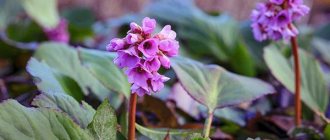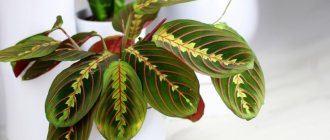Akalifa stands out among other ornamental plants with its original leaf color and unusual inflorescences, reminiscent of a fox tail. It is for this feature that it received its second name - foxtail. The shape of the leaves is slightly reminiscent of nettle leaves, so the plant was named Akalitha (translated from Greek - nettle).
Home care
An experienced florist is quite capable of creating conditions so that akalifa retains the decorativeness and richness of the leaves and grows normally, constantly forming ovaries and delighting with its unusual flower-tails.
Just be sure to work with the plant with gloves, remembering that it is poisonous. And make sure that neither children nor animals have access to the bush.
Location and lighting
The foxtail needs long daylight hours to function properly. Therefore, in winter, place the plant on a south-facing windowsill and add a lamp. In summer, shade slightly so that there is light, but without direct sunlight. When it’s warm, you can put the pot on the balcony or even in the yard. But make sure that it is not windy and without drafts.
If there is not enough light for the Polynesian friend, the stems will stretch upward unattractively, and the leaves will lose their variegated decorativeness, becoming pale. You can safely place the akalifa on the kitchen window - smells and steam will not harm it.
Temperature
A tropical plant, of course, prefers warmth. In the room where the foxtail is kept, the temperature should not drop to +16°C. In summer, it is advisable to maintain 22-25 degrees; in winter, you can slightly reduce the temperature to +18°C. But if the apartment is warmer, there is no need to specifically lower the temperature. Make sure that the window sill is not too cold during the cold season and does not cool the soil in the pot.
Watering
Pacific nettle is a well-known water feeder. The higher the temperature in the room, the more often it is necessary to add life-giving moisture. In summer this is done approximately once every two days, in winter - once a week. The water should be purified, acidified, settled and slightly heated (up to 20 degrees). If you overfill and water appears in the pan, do not leave it, but immediately drain the excess.
In winter, the amount of watering should be reduced. But if the house is very warm, make sure that the soil always remains moist. A decrease in temperature and infrequent watering will cause the akalifa to go into hibernation.
Air humidity
Create a humid atmosphere around the foxtail. To do this, spray the air around the plant as often as possible. You can place the pot in a tray filled with damp peat. To maintain high air humidity, you can place a jar of water nearby. If possible, use a humidifier.
The soil
For a representative of the Euphorbiaceae family, select a soil mixture that is light and well-permeable to moisture and air. You will need the following components:
- 40% turf land;
- 15% leaf;
- 20% greenhouse;
- 5% sand;
- 5% acidic high peat;
- 15% leaf soil.
To avoid fussing with ingredients, you can purchase a ready-made rose mixture at a flower shop. Just be sure to line the bottom of the pot with drainage, and then you can add soil.
Feeding and fertilizers
In winter, the bush does not need feeding. And from March to October, fertilizers will need to be applied every two weeks. Alternate mineral and organic fertilizers. This is important, since at this time Akalifa spends a lot of energy developing buds and flowering.
Transfer
Foxtail should be replanted in the spring. Just don't choose a pot that's too big. The roots of the Polynesian green friend prefers tight spaces. You don’t have to replant the whole bush at all, but simply replace the top layer of soil with fresh soil, always with a slightly acidic reaction.
While the plant is young and growing intensively, change containers every year, and in adulthood it will be enough to move to a new pot every 3-4 years. When transshipping, shorten the sprouts by half.
Before transplanting, be sure to disinfect the pot. Pour drainage into it 2 cm - expanded clay or gravel. Pull out the plant along with a lump of earth, remove damaged particles. Place the new pot in the center and add fresh soil.
Be sure to wear gloves, not forgetting about the toxicity of the ward.
Having noticed that the acalyph has degenerated and lost its decorative effect, cuttings should be taken from it, and there is no point in replanting the plant itself.
Trimming
This beauty must be pruned ruthlessly in February in order to rejuvenate and preserve the bush. Otherwise, in two years it will turn into an unattractive plant without specific characteristics. Leave the stump at 20-30 cm. To make it produce young shoots faster, cover it with a glass jar or stretch polyethylene over it. To stimulate growth, treat it with Zircon solution. Every day, remove the jar, spray and ventilate the bush, or rather, what’s left of it.
While Akalifa is young, constantly pinch the top of the shoots for better branching and development of lateral buds.
The necessary conditions
Akalifa cannot be called picky, but it has clear requirements for both humidity and air temperature, and lighting.
Life in diffused light
Try to find the brightest possible place for the plant. In the shade, the color of the “Copper Leaf” will fade, and the inflorescences of the “Fox Tail” will decrease. In winter, additional lighting may be required in the evening hours. Do not keep akalifa in direct sun - this can cause burns and dry out of the soil.
The foxtail is most comfortable on an east or west window. If it is on the south side, shade the bush on sunny days. On the northern windowsill, the foxtail does not have enough natural light, the stems stretch out and the leaves turn pale, flowering occurs later, the shades of the “tails” are duller.
Bloom
Foxtail usually blooms for six months. Spikes of flowers of scarlet, burgundy and other shades of red fall down. Occasionally there are pink, white and even green specimens.
They form especially intensively in summer. Remove faded, dried ovaries to preserve the plant’s strength for new flowers.
In the wild, Akalifa can bloom all year round. If you create conditions that are as close to tropical as possible, then your ward will extend the flowering period to the maximum, releasing as many catkins as possible. Every year the inflorescences will become longer and longer.
Possible difficulties
If agricultural practices are violated, foxtail may suffer from fungal diseases. In damp rooms, leaf spot develops (wet dark brown spots form on the leaves).
In insufficient light, the leaves become pale, almost white. If the tips of the leaves dry out, the air in the room is too dry. The appearance of dark spots on the leaves at moderate humidity indicates drafts or too low temperatures.
Sometimes aphids, whiteflies and spider mites settle on acalypha. If parasites are detected, the crown is treated with an insecticide.
Reproduction
Usually, foxtail is propagated in two ways - by sowing seeds or cutting apical cuttings. Fiddling with seedlings is recommended only for experienced gardeners, while beginners or people with limited free time are better off using the second method. And bushes grown from seeds look worse and grow more slowly.
Propagation by seeds
Sow seeds in March. Before sowing, soak for 24 hours in Zircon solution. Deepen the seed 5-6 mm into the sand-peat mixture. Spray with water and cover with film. Place in the light so that the container is not exposed to direct sunlight, and cover with plastic wrap. Be sure to remove the film every day, moisturizing and ventilating the plantings.
The room should be moderately warm: +20-22°C. If possible, arrange lower heating - this way the shoots will appear earlier and more efficiently. If the temperature drops regularly at night, your crops may die.
As soon as the seedlings reach 2-3 cm, plant them in separate pots or plastic glasses. Take soil as for an adult plant. And handle the roots very carefully so as not to damage them.
Propagation by cuttings
You can root cuttings throughout the year, but it is best to do this in the spring. To do this, cut off the apical shoots that have become lignified to a length of 8-10 cm. Don’t bother with young or side shoots - you’ll waste your time and energy. Treat the cut areas with a root growth stimulator and break off the lower leaves.
The cuttings can be placed in water to allow roots to sprout, or they can be immediately planted in a turf-sand mixture. With constantly moist soil, sufficient light and an air temperature within +20-25 degrees, there will be no reason for Akalifa not to take root. Cover the cuttings with film, ventilating and moistening the sprouts every day.
After rooting, plant them in separate pots. Gradually get used to bright sunlight. After a month and a half, be sure to pin it, removing the upper buds.
Reproduction methods
Akalifa is propagated in two main ways:
- seeds;
- vegetatively.
Germination of seeds
For sowing, prepare a small container that can be covered with a lid or glass. A drainage layer is poured onto the bottom and a loose nutrient substrate is distributed.
The soil is moistened before planting the seeds. The optimal temperature for germination is 20...22 °C .
Place the container in a warm, well-lit place, opening it for a short time every day for ventilation. When the seedlings produce two true leaves, the lid can be removed and the sprouts can be plucked.
Rooting cuttings
It is considered the most effective method of vegetative propagation . In the spring, during pruning, cuttings of at least 10 cm in length are prepared.
The cut is treated with a root formation stimulator and planted in a mini-greenhouse with nutritious loose soil. Approximately 50 days after planting the cuttings, their tops are pinched to stimulate the formation of side shoots.
Air layering
Another vegetative method of propagation. It is used infrequently, although it gives good results. Work usually starts in September:
- On a relatively young (not lignified) shoot, an area of 8 cm is cleared of leaves.
- Make a deep circular cut and put a bag of sphagnum on the branch, which is distributed around the cut.
- The package is fixed at the cut site.
In spring, the cuttings with formed roots can be separated from the mother plant and planted in an individual container.
Important! Make sure that the moss is slightly damp at all times, this is necessary for successful root formation.
Diseases and pests
Don't worry about akalifa attracting pests. This happens extremely rarely.
But if you notice yellow spots on the leaves and white cobwebs, it means a spider mite has attacked. Spray the bush with tobacco infusion. Animal shampoo, which contains components that fight ticks, will also help.
If you see whitefly larvae on the bottom of the leaves, treat them with insecticides.
If the leaves curl into tubes, it means that aphids have entered the battle. Remove the pests and spray with a poison that includes permethrin. You can also use tar soap.
The appearance of brown or powdery spots on the leaves signals the spread of the fungus. Treat foxtail with fungicide twice, 10 days apart.
Care errors
Keep a close eye on Asian nettles. If you notice negative changes in appearance, it means you are not caring for the plant correctly.
Yellow and crumbling leaves indicate a lack of light and moisture. Add a phytolamp and spray the bush more often.
Withering, crumbling foliage indicates that the temperature is too low.
Pale elongated leaves are observed when acalife does not get enough light. Move the pot to a south window.
Slow growth and pale leaves indicate that it is time for fertilizers that contain nitrogen.
Dark spots on the leaves appear from drafts or hypothermia.
Propagation of the Fox Tail flower
Reproduction is most often carried out by cuttings; in rare cases, planting is carried out using seeds:
- The cuttings should be about 8cm long.
They take root well and quickly take root in the sand. The temperature for normal rooting should be about 25 degrees. The plant needs to be constantly moistened. After the first buds and leaves appear, the flower can be transplanted to a permanent place. Such manipulations are recommended to be carried out in the summer. - Seeds are planted in the ground in early spring. This will require a mixture of peat and sand. After planting, the ground is covered with film. Periodically it needs to be moistened and ventilated. After two leaves appear, the seedlings are planted at a distance of 3-4 cm from each other.
Kinds
The Akalifa genus has more than 450 species, varieties and hybrids. Not all of them are grown at home. Most often you can find representatives of one of two large groups:
Akalifa bristle-haired
A bush with lush greenery grows up to 50 cm with ovoid leaves of a bright green color. It can bloom all year round with large bright red flowing “tails”. If the inflorescences are white, it is the Alba variety. Prized for its unusual flowers.
Vilkez's foxtail
The evergreen shrub is grown primarily for its bronze-green leaves flecked with coppery red and edged with pink. But the pale pink flowers, collected in inflorescences, are the most ordinary - no more than 10 cm in length. Blooms throughout June-August.
Description
Akalifa is a plant that grows wild in tropical rainforests of Southeast Asia and the Pacific Islands. There are more than 450 flower species in the genus.
Translated from ancient Greek, the name is translated as “nettle”. They emphasized the special shape of the leaves, which are the same as those of nettles. In the wild, the bush grows greatly. It has many inflorescences that hang down.
At home, Akalifa looks more modest. The length of the shoots rarely exceeds 70 cm. To make the shoots branch, the tips are pinched. The leaves are ovate and have serrated edges. The color of the unusual flower is all shades of pink. You will find a description, types and features of caring for this plant in a separate article.
The color depends on the type of crop. They can be bright green or green with a bronze tint and various splashes and touches of red. Leaves length is up to 20 cm.
Flowering also depends on the Akalifa variety. In some species, the flowers are especially decorative. The inflorescences have the shape of spikelets of bright red color. The length of the fluffy inflorescences can reach half a meter. In other species, the inflorescences are not so large, their length does not exceed 10 cm.
Interesting to know: the plant comes from the tropical regions of Asia, the island of Fiji. The culture can also be found in the nature of Australia and Polynesia.
The genus includes both annual and perennial varieties. Among them you can find herbaceous crops, shrubs and even trees.
Folk signs
Akalifa is a symbol of balance and helps to find harmony. It will warm those who are often cold. Spendthrifts will be taught to save. The letter eater will make you appreciate your spiritual qualities. Any maximalist will be led to the “golden mean”.
It will affect not only character, but also the harmonization of the work of all organs and systems within the body. Especially indicated for heart patients.
Men in a house where foxtail grows will become steadfast and reliable, and women will become soft and loving. There will be no place for laziness, despondency, or pessimism in the house.
Now you know almost all the secrets of the miracle flower. By devoting a little time and effort to the plant, you will get a simply fabulous result in the form of living “fox tails”.











